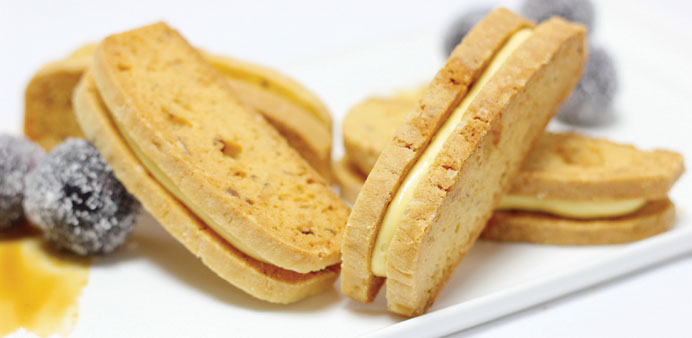Tarun Kapoor is executive chef at Doha’s Horizon Manor Hotel. Send your feedback to:
[email protected]
I have been a cookie lover since my childhood and am always fond of the multiple varieties available in various bakeries around my house. The one which is undoubtedly my favorite is biscotti — the twice baked Italian cookie. I even keep a jar filled with biscotti in my office to nibble on them when I feel the urge to eat something.
The word biscotti means twice baked, which is how they get their dry, crisp texture. Biscotti have been enjoyed as a staple food by many for thousands of years. There are records of Roman Legions baking them for their long journeys, because being dry, they were light to carry and would remain fresh almost indefinitely, running little risk of developing moulds due to their less moisture content.
Though modern biscotti are associated with the Tuscan region of Italy, the popular Italian cookie traces its origins to Roman times. The word biscotto derives from “bisi”, Latin for twice, and “coctum” or baked, which became “cotto”, or cooked. Biscotti are also the generic term for cookie in Italian. Traditionally an Italian classic, biscotti have been baked for centuries.
The Roman biscotti were more about convenience food for travellers rather than a pleasurable treat for leisurely dinners. Unleavened, finger-shaped wafers were baked first to cook them, then a second time to completely dry them out, making them durable for travel and suitable nourishment for long journeys.
The Roman historian, Pliny the Elder, boasted that they would be edible for centuries. Biscotti were a staple diet of the Roman Legions. It was the perfect food for sailors who were at sea for months at a time. Biscotti were a favourite of Christopher Columbus who relied on them on his long sea voyage.
After the fall of the Roman Empire, the country was repeatedly ransacked by vandals. The people did their best to survive and there was no culinary development.
During the renaissance, cuisine also flourished. Biscotti re-emerged in Tuscany, credited to a Tuscan baker who served them with coffee. Their dry, crunchy texture was deemed to be the perfect medium to soak up the coffee. Centuries later, many still agree that dipping biscotti in coffee is a perfect way to end a meal, or to while away an afternoon at a café.
The first documented biscotti cookie recipe is called “genovese” from Genoa. It was found in a manuscript written down by Amadio Baldanzi, a resident of Prato from the 18th century. But today, because of biscotti’s popularity in coffee houses, many different ingredients are added for variations.
They are enjoyed as a breakfast biscuit, dunked in coffee, alongside a dish of Gelato, and of course, biscotti are savoured as a subtly sweet crispy snack all by themselves. And can be enjoyed any time of the day.
Chocolate Biscotti
Ingredients
Butter unsalted 350 gm
Eggs 6 no
Castor Sugar 1.5 cup
Flour 6 cups
Salt A pinch
Baking powder 2 tsp
Almond Half cup
Vanilla extracts 2 tsp
Fennel seeds 1 tbsp
White chocolate 1 cup
Method
Sift flour, salt and baking powder and keep aside.
Cream butter with sugar till light and fluffy and the sugar is dissolved.
Gradually add the eggs, vanilla extracts and continue to mix.
Now add flour mixture slowly. Continue mixing.
Add crushed almonds and fennel seeds and make a stiff dough.
Allow the dough to rest for an hour in refrigerator.
Divide the dough into equal parts and shape them into two-inch-wide rectangles.
Arrange in a baking tray and bake at 180 degree Celsius for 25-30 minutes.
Remove from the oven and allow them to cool down; refrigerate for another 2 hours.
Thin slice into half-centimetre biscotti and arrange on a baking tray and bake again at 180 degree Celsius for 10-12 minutes.
Keep an eye on the biscotti as the baking time will depend on the thickness of the slice.
Once the biscotti is crisp, remove and allow to cool and store in air tight containers.
To make chocolate sandwich biscotti pipe some melted white chocolate in between two biscotti and combine them together.
Let them rest for a while for chocolate to set and serve later.
Note: To make a single chocolate biscotti, dip the prepared biscotti in melted chocolate from one side and allow to set for a while. Store biscotti in air tight containers and enjoy them over the next few weeks.

CRUNCHY: Italian Biscotti.


